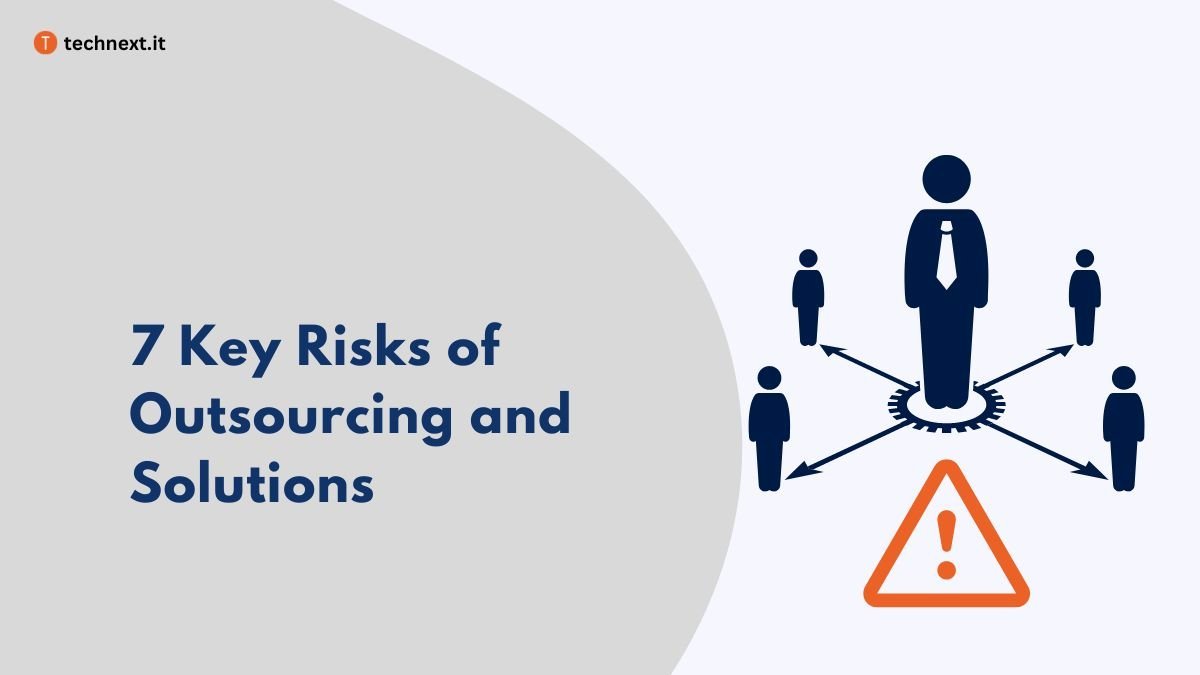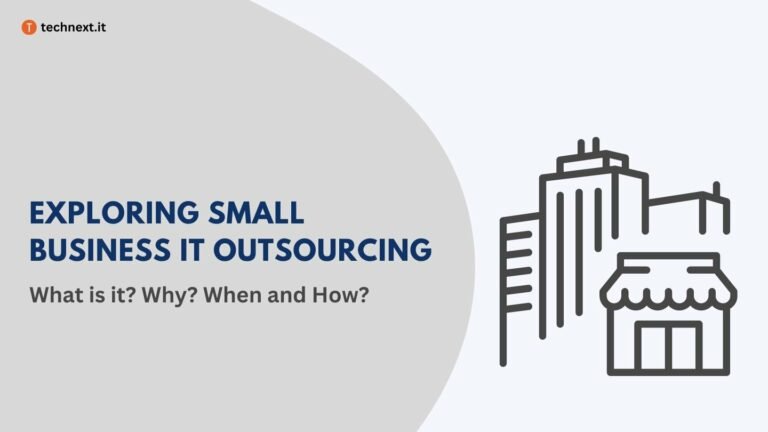7 Key Risks of Outsourcing and Expert Advice to Avoid Them
In this article, we will discuss 7 common risks of outsourcing that companies face and provide expert advice on how to mitigate them to ensure success.

Back in the 1980’s companies heavily began adopting a magic solution to offload some of their headaches, “Outsourcing.” After the IT boom, businesses realized that they could now outsource their work to offshore vendors and substantially reduce their operational costs.
As a result, the market of outsourcing, mainly IT outsourcing, has spread like wildfire and is projected to reach US$777.88bn by 2028. And we all know that whenever something experiences rapid growth, risks and challenges tend to arise. Outsourcing is no exception.
As a person navigating the IT outsourcing world for over 12 years, I have noticed that most businesses face five to 10 problems while outsourcing their IT and development efforts.
Today, I will discuss the 7 key risks of outsourcing that I have either personally experienced or that my clients have shared with me. Fortunately, most outsourcing risks and challenges can be easily managed, so I’ve also proven effective solutions for these outsourcing risks so that you and someone new can outsource without fear.
1. It’s hard to find the right outsourcing partner
We all know that the success of your outsourced project largely depends on an outsourcing partner. Unfortunately, finding the right development outsourcing partner is not that simple, even in 2023.
Don’t get me wrong; I am not saying there aren’t much good outsourcing providers. In fact, the number of outsourcing service providers has increased exponentially in the last two decades.
Regrettably, not all those providers are qualified enough. This is previously what created the problem. This flood of outsourcing service providers made the search process even more challenging for companies looking to outsource.
The finding process has gotten even harder for companies in recent times because of AI. AI, like ChatGPT, Midjourney, etc., made it easier for any company to appear competent as they can now finetune their ads with AI now.
So, what happens when you choose one of those companies as your development partner? Simply put, they will just waste your time and resources and make your entrepreneurial journey harder.
How to resolve this problem?
Honestly, there’s no shortcut to finding a trustworthy outsourcing partner. Yes, you can go for large providers, but there’s an opportunity cost. You may miss the opportunity of finding better deals.
So Take your time and make an effort to make an informed choice to reduce the challenges and risks of outsourcing by a large amount. And while researching, must do the following things:
- Make a list of potential outsourcing providers, go through all of them, and make a decision after a swat and opportunity cost analysis.
- Nothing says more about a provider’s capabilities than its portfolio. So take your time to analyze their portfolio.
- Read client reviews and talk to them personally. Ask everything.
- Ask for a free trial.
Read “Founder’s Guide to Outsourcing Software Development” for detailed information.
2. Communication challenges
Even if you find a qualified outsourcing partner, you may face a serious issue, and that is the “Communication barrier.” When you are outsourcing, a lack of communication between you and service providers can lead to misunderstandings, delays, and accountability issues.
People often mistake language proficiency for communication. However, communication is far more than just talking to the team members.
In the professional world, effective communication involves understanding the concept, exchanging ideas, proper and timely reminders, understanding the requirements, and many more.
While face-to-face contact can make communication easier, it is not the primary factor that is absent in outsourcing. Miscommunication mainly occurs due to the difference in work culture.
How to avoid the lack of communication with the outsourced team?
To prevent miscommunication, the first thing you should do is acknowledge the differences between your team and the outsourcing partners and take action according to them.
Say the business hours for you are different from your outsourcing partner; try to specify core business hours that take into consideration both time zones. Understood the baseline? Here are a few things you may do to minimize the risks of miscommunication:
Before hiring the outsourcing partner
- Make sure your offshore development partner has proficiency in your language or a language you speak, say English.
- Make sure both companies have similar work cultures. If you are a startup and believe in a flexible working environment, then choose a partner who believes in the same thing.
After hiring the outsourcing partner:
- Use collaboration tools like Slack, google meet, etc, for effective communication.
- Create a guideline for communicating. Most outsourcing teams operate in different time zones, so they can’t communicate with you for every need. So set a guideline to let them know when they must share with you and what should be the means of communication.
- Schedule regular meetings with the outsourced team to discuss project progress, tasks, challenges, milestones, etc. These meetings can be weekly or bi-weekly, depending on the project’s complexity.
Effective communication is a relative thing, and various companies adopt different methods of communication to ensure its effectiveness. Find out what works best for you, as the founder of Plainly did for his company. Read what he said about communicating with an outsourcing partner when we reached out to him.
Communication is a key aspect of any successful partnership so before establishing any kind of cooperation, make sure that the business/person you are partnering with is able to communicate and respond to feedback constantly.
Create a detailed plan with clear goals and deadlines regarding product development and ensure that your partner agrees that it’s doable. Working in different time zones can cause many issues, but since we do quite a bit of business with freelancers, we worked out this problem through briefings using Loom, it’s a super convenient tool that enables async communication.
People worldwide have completely different working habits, so cultural differences may occur and you have to be open-minded to overcome them and work through them. During projects like these, technical difficulties will inevitably happen from time to time. When they do happen, people tend to blame one another because of frustration, which leads to more issues. I am probably repeating myself, but I cannot stress this enough, communication is the absolute star of any successful partnership.

– Nebojsa Savicic (Co-founder of Plainly)
3. Risk of reduced authority
Problems like miscommunications and lack of control make outsourcing vulnerable to another problem; clients don’t get the whole picture. And this eventually leads to reduced authority.
“When you outsource, you lose direct monitoring and decision-making ability. This can result in a misalignment with your objectives, values, or quality standards. Many of my clients share their concerns about losing control over process technologies and quality standards.
How to avoid this risk?
- Prepare a clear plan for your project.
- Choose an experienced software development firm that shares your vision.
- Write a detailed contract that includes specifications for the task, quality, delivery targets, KPIs, and timeline.
- Establish transparency and trust to minimize the risk of reduced authority.
4. Unanticipated expenses in outsourcing
This is by far the most common type of risk you can face while outsourcing. As you know, one of the main benefits of outsourcing is the opportunity for cost saving, but inadequate cost management can lead to hidden costs.
You can consider factors tax implications, software upgrades, industry conditions, raising prices, demand, strategic alignment, etc., as hidden costs. My recommended solution for overcoming this risk is as follows.
How to avoid unexpected expenses in outsourcing
- List all direct and indirect expenses for a thorough cost analysis.
- Ensure the outsourcing contract specifies charges and prices.
- Include measures for the outsourcing partner to inform you of any extra fees and obtain your permission before charging.
- Define project deliverables and timelines to track expenses and prevent unauthorized or unexpected costs.
5. Risk of privacy and security
There will be some security risks whenever you hand over a development project to another company or person. As a result, privacy and security concerns are the most critical risk for you as a founder.
While outsourcing, you entrust external parties with the most sensitive information of your company, like customer records, financial data, and intellectual property heightens data security and IP protection concerns.
Your company can face financial and reputational damage if any of this data gets leaked or stolen. In my opinion, preparing beforehand is the solution for this type of situation.
How to avoid security risks in outsourcing
- Start by validating the security measures of any possible outsourcing partners. After choosing the right one, you need to implement Non-disclosure agreements (NDAs).
- Make it clear how the data that is shared will be kept safe in your contracts.
- Try hiring outsourcing providers who are registered in the USA; this way, you can take legal action if necessary.
- Only outsource non-sensitive portion. For example, many companies outsource front-end development while the in-house team handles their back-end development.
6. Unacceptable quality in the outsourced product
Outsourcing can be effective for your businesses but often comes with risks like the unacceptable quality of outsourced products. This happens when you struggle to maintain constant quality standards.
Poor quality work can harm your operations, reputation, and client satisfaction, wasting resources, delay issues, and missed opportunities.
How to maintain quality of work
- Honestly, you can get low-quality work even from your in-house team if you don’t supervise them well. I’m not saying you need to continually monitor your offshore partner; at least make sure they have a high-quality developer to oversee it.
- Go for staff augmentation instead of a custom project; this way, you can ensure you are getting good-quality developers and paying only for them.
- Check if they use Quality Assurance (QA) methods, code review, and up-to-date DevOps techniques.
- Monitor the work of the outsourced team regularly to ensure high-quality results.
7. Inexperience in managing remote teams
Unlike other risks and challenges, this one originates from the customer. Maintaining a remote team is quite different from managing an internal team. Must be technically sound and active in monitoring.
Also, if you are taking IT outsourcing services, you must also have technical knowledge.
So what happens when you fail to lead your offshore development teams? It may lead to a disengaged and unmotivated team, resulting in missed deadlines and under-delivery of your work.
How to avoid this risk?
- Prepare yourself, and understand remote work dynamics. Learn the best practices. There are plenty of resources available to help you prepare. GitLab offers a good course on Coursera; you may check that out.
- Take a technical co-founder or CTO who knows how to manage remote teams. If you are short on resources, consider CTO as Service.
- Improve your remote leadership skills, such as time management, self-discipline, and motivating remote teams, among other things.
How Technext mitigates risks of outsourcing for partners
Technext is an outsourcing-focused software development company with 10+ years of experience in the industry. With a 50+ strong team, Technext provides software development outsourcing services.
In the last 10 years, we have developed a system where our partners can get effective services without worrying about the risk associated with outsourcing. Over the past decade, we have established a system that allows our partners to receive efficient services without any concerns about the potential risks associated with outsourcing.
So, what makes our clients put their trust in us?
- First Technext is registered in Delaware, USA, as ThemeWagon, Inc. We send our invoices from this business. If we don’t deliver as promised, they can take legal steps (That never happened).
- Technext provides free consultations to potential clients even before they officially take our services. This helps build trust with them.
- Technext always maintains transparency in our billing process. Our clients are informed beforehand about every single cent they will be charged.
- Technext provides a 7-day risk-free trial to ensure that our clients know exactly what they will receive if they decide to make us their outsourced partner.
Looking for a trustworthy outsourcing partner? Schedule a complimentary consultation.






